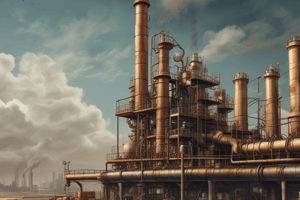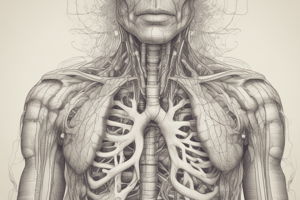Podcast
Questions and Answers
Which gas has the highest percentage in air?
Which gas has the highest percentage in air?
- Carbon dioxide
- Nitrogen (correct)
- Oxygen
- Argon
What is the primary use of oxygen in welding?
What is the primary use of oxygen in welding?
- To create a protective atmosphere
- To enhance combustion (correct)
- To prevent oxidation
- To cool the materials
Which gas is denser than air and is useful for putting out fires?
Which gas is denser than air and is useful for putting out fires?
- Oxygen
- Argon
- Carbon dioxide (correct)
- Nitrogen
What is the potential consequence of breathing in pure oxygen?
What is the potential consequence of breathing in pure oxygen?
Which gas is chemically inactive and does not support life?
Which gas is chemically inactive and does not support life?
What is the purpose of oxygen absorbers in food packages?
What is the purpose of oxygen absorbers in food packages?
What maintains the stability of oxygen and carbon dioxide content in the atmosphere?
What maintains the stability of oxygen and carbon dioxide content in the atmosphere?
Which gas is suitable as a replacement for nitrogen in certain uses and for better heat insulation?
Which gas is suitable as a replacement for nitrogen in certain uses and for better heat insulation?
What is the key property of carbon dioxide that makes it useful for keeping food cold?
What is the key property of carbon dioxide that makes it useful for keeping food cold?
How are gases in air separated based on their different properties?
How are gases in air separated based on their different properties?
What is the percentage of nitrogen in air by volume?
What is the percentage of nitrogen in air by volume?
Which gas forms the highest percentage of air?
Which gas forms the highest percentage of air?
What is the purpose of making a pie chart to show the composition of air?
What is the purpose of making a pie chart to show the composition of air?
Which gas is chemically inactive and does not support life?
Which gas is chemically inactive and does not support life?
What is the primary gas responsible for allowing living things to survive?
What is the primary gas responsible for allowing living things to survive?
Which gas is responsible for forming only a small percentage of air but is essential for photosynthesis?
Which gas is responsible for forming only a small percentage of air but is essential for photosynthesis?
What is the purpose of oxygen absorbers in food packages?
What is the purpose of oxygen absorbers in food packages?
Which gas is denser than air and is useful for putting out fires?
Which gas is denser than air and is useful for putting out fires?
What is the potential consequence of breathing in pure oxygen?
What is the potential consequence of breathing in pure oxygen?
Which gas is suitable as a replacement for nitrogen in certain uses and for better heat insulation?
Which gas is suitable as a replacement for nitrogen in certain uses and for better heat insulation?
What percentage of air is nitrogen?
What percentage of air is nitrogen?
What gas makes up the second largest percentage of air?
What gas makes up the second largest percentage of air?
What is the purpose of making a pie chart in the context of the text?
What is the purpose of making a pie chart in the context of the text?
Why is it important to understand that air is not a single gas?
Why is it important to understand that air is not a single gas?
What is the purpose of rounding up the numbers to the first decimal point in making the pie chart?
What is the purpose of rounding up the numbers to the first decimal point in making the pie chart?
Which gas in air is often associated with global warming and climate change?
Which gas in air is often associated with global warming and climate change?
What is the main gas responsible for facilitating respiration in living organisms?
What is the main gas responsible for facilitating respiration in living organisms?
What does the text emphasize about the importance of 'fresh' air?
What does the text emphasize about the importance of 'fresh' air?
What is the purpose of the 'Snapshot' on p. 14 mentioned in the text?
What is the purpose of the 'Snapshot' on p. 14 mentioned in the text?
Why is it important for scientists to understand the composition of air?
Why is it important for scientists to understand the composition of air?
Flashcards are hidden until you start studying
Study Notes
Testing for Gases in Air
- The text describes experiments to test for gases in the air, including oxygen, carbon dioxide, and nitrogen, as well as distinguishing between dry and wet air and testing for water vapor.
- The experiments involve using stoppered boiling tubes and various indicators, such as lime water and hydrogencarbonate indicator, to observe the reactions of different gases.
- Safety precautions, such as wearing safety goggles and being careful when handling a naked flame, are emphasized throughout the experiments.
- Results of the experiments include the reactions of burning and glowing splints, changes in indicators, and the use of dry cobalt chloride paper to test for water vapor.
- The text also includes an analysis of the results and suggestions for suitable tests for each gas, as well as questions for further discussion.
- The experiments aim to help students learn how to distinguish between different gases in the air and understand their properties, such as oxygen's role in supporting life and fueling combustion.
- Oxygen, which makes up about one-fifth of air, is described as essential for burning and supporting life, with a low boiling point and slightly denser than air.
- The text also discusses the use of nitrogen, which is chemically inactive and has no simple test, as well as the properties and uses of water vapor in daily life.
Studying That Suits You
Use AI to generate personalized quizzes and flashcards to suit your learning preferences.




